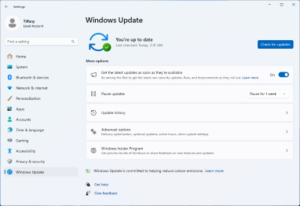
Back ويندوز أبديت Arabic Windows Update Bulgarian উইন্ডোজ আপডেট Bengali/Bangla Windows Update BS Windows Update Catalan Windows Update Czech Microsoft Update German Windows Update Greek Windows Update Spanish Windows Update Estonian
 Windows Update on Windows 11 | |
| Other names | Microsoft Update |
|---|---|
| Developer(s) | Microsoft |
| Operating system |
|
| Included with |
|
| Service name | Windows Update |
| Type | Network service |
| Website | support.microsoft.com/en-us/windows/windows-update-faq |
Windows Update is a Microsoft service for the Windows 9x and Windows NT families of the Microsoft Windows operating system, which automates downloading and installing Microsoft Windows software updates over the Internet. The service delivers software updates for Windows, as well as the various Microsoft antivirus products, including Windows Defender and Microsoft Security Essentials. Since its inception, Microsoft has introduced two extensions of the service: Microsoft Update and Windows Update for Business. The former expands the core service to include other Microsoft products, such as Microsoft Office and Microsoft Expression Studio. The latter is available to business editions of Windows 10 and permits postponing updates or receiving updates only after they have undergone rigorous testing.
As the service has evolved over the years, so has its client software. For a decade, the primary client component of the service was the Windows Update web app that could only be run on Internet Explorer. Starting with Windows Vista, the primary client component became Windows Update Agent, an integral component of the operating system.
The service provides several kinds of updates. Security updates or critical updates mitigate vulnerabilities and security exploits in Microsoft Windows. Cumulative updates are updates that bundle multiple updates, both new and previously released updates. Cumulative updates were introduced with Windows 10 and only some been backported to Windows 7 and Windows 8.1. Windows 11 24H2 also introduced checkpoint cumulative updates[1] and updates with Hotpatch capable in the name, where some of the updates no longer require reboot.[2][3]
Microsoft routinely releases updates on the second Tuesday of each month (known as the Patch Tuesday B updates), but can provide them whenever a new update is urgently required to prevent a newly discovered or prevalent exploit, so called out-of-band updates.[4] System administrators can configure Windows Update to install critical updates for Microsoft Windows automatically, so long as the computer has an Internet connection.
In Windows 10 and Windows 11, the use of Windows Update is mandatory, however, the software agreement states that users may stop receiving updates on their device by disconnecting their device from the Internet.[5][6]
There also exist C and D updates,[7] that users enroll in when they click the update button.[8]
- ^ "Introducing Windows 11 checkpoint cumulative updates". TECHCOMMUNITY.MICROSOFT.COM. Retrieved 16 October 2024.
- ^ robinharwood (10 October 2023). "Hotpatch for Windows Server Azure Edition". learn.microsoft.com. Retrieved 16 October 2024.
- ^ Zorz, Zeljka (23 September 2024). "Windows Server 2025 gets hotpatching option, without reboots". Help Net Security. Retrieved 16 October 2024.
- ^ "May 23, 2024—KB5039705 (OS Build 17763.5830) Out-of-band - Microsoft Support". support.microsoft.com. Retrieved 16 October 2024.
- ^ "Microsoft License Terms". www.microsoft.com. Section 13b. Archived from the original on 1 August 2015. Retrieved 30 March 2020.
- ^ "Microsoft Software License Terms". www.microsoft.com. Archived from the original on 1 May 2023. Retrieved 20 July 2022.
Canada. You may stop receiving updates on your device by turning off Internet access. If and when you re-connect to the Internet, the software will resume checking for and installing updates.
- ^ Hoffman, Chris (12 December 2018). "Now Windows 10 Has C, B, and D Updates. What is Microsoft Smoking?". How-To Geek. Retrieved 16 October 2024.
- ^ Fortin, Michael (10 December 2018). "Windows monthly security and quality updates overview". Windows Experience Blog. Retrieved 16 October 2024.